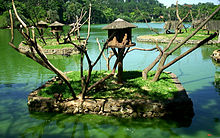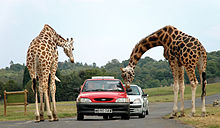User:Donlammers/Sandbox/Zoo stub
{{No footnotes|date=May 2010}} {{Refimprove|date=May 2010}} {{Primary sources|date=May 2010}}
| Donlammers/Sandbox/Zoo stub | |
|---|---|
 | |
| 39°57′36″N 105°30′35″W / 39.9599411°N 105.5096537°W | |
| Date opened | 1995 [1] |
| Location | Nederland, Colorado, United States |
| Memberships | AZA,[2] ZAA,[3] BIAZA,[4] EAZA,[5] WAZA[6] |
| Website | wildbear |
The Wild Bear Mountain Ecology Center (or just Wild Bear) is an environmental education organization founded in 1995 and located in Nederland, Colorado.
History
[edit]Wild Bear was founded in 1995 by Nederland school teacher Jill Dreves who wanted to help bring her students outdoors to learn about nature and the environment. Wild Bear began with only 24 students, but by 2010 was serving 4000 people of all ages per year in after school, weekend, and summer programs.[1]
Exhibits
[edit]Events
[edit]In the annual Enchanted Forest hike, held at Mud Lake, families are led through Linnea's Loop trail. During the hike they meet animals of the forest (volunteers in costume). In 2010, the animals included a raccoon, mountain lion, black bear, coyote, and owl.
Education
[edit]Conservation
[edit]The future
[edit]The center hopes to build a permanant home at Mud Lake, where Wild Bear owns 5 acres (2.0 ha) of land. Although there is no set timeline for the project, plans call for a 8,250-square-foot (766 m2) solar-powered nature center on the Mud Lake property.
Modern zoos
[edit]This section was badly in need of rewrite anyway, and someone deleted it. Saving here because regardless of opinion, this is what modern zoos claim to be doing (whether they are being successful or not is a separate question). Hoping that I will have time to work this into better condition over Christmas (we'll see). Tags claimed "weasel-words" and "needs improved references".
Modern zoos have evolved a long way[unbalanced opinion?] from their early origins and there is now a growing divide between those progressive zoos which strive to maintain best possible standards in animal welfare, education, conservation and research output, and those less responsible institutions which are focussed more on economic return and entertainment.
The best zoos generally work within well-structured regional associations, such as those members of the British and Irish Association of Zoos and Aquariums (BIAZA), the European Association of Zoos and Aquariums (EAZA) the US Association of Zoos and Aquariums (AZA) and the World Association of Zoos and Aquaria (WAZA).
The aims of a good modern zoo include the following:
- To breed endangered species
- To co-operate in conservation breeding programmes with other zoos
- To educate visitors about animals and conservation issues
- To maintain high standards of animal welfare
- To carry out scientific research
- To support the conservation of animals and their habitats in the wild
Breeding in Modern Zoos
Good zoos aim to be self-sustaining in terms of their stock and wild animals are only taken into zoos for breeding in exceptional circumstances.[unbalanced opinion?] Examples include wild animals which are confiscated from the illegal trade, wild-injured animals or birds rescued and rehabilitated by a zoo or (rarely) authorized removal of animals from the wild for conservation work in emergency situations. Zoos therefore work together through a network of national and international breeding programmes in order to control numbers and ensure maximum possible genetic diversity.
Over 1000 species or subspecies are now managed via a conservation[7] breeding programme, and over 163 species or subspecies are managed through a studbook. In this case a species co-ordinator uses computer software to record and analyse each individual animal’s genetic history to produce an inbreeding coefficient for each animal. This can be used to create hypothetical pairings of animals which the studbook keeper can assess for relatedness before they make recommendations to the zoos which are responsible for housing and transporting each individual.
Conservation in modern zoos
Good zoos throughout the world are becoming a powerful force for conservation, working as part of a global conservation network guided by the World Zoo and Aquarium Conservation Strategies[8] and the International Union for Conservation of Nature (IUCN). Conservation activities can generally be grouped under two main headings; ex situ conservation refers to work that occurs outside of the animal’s home range,which usually consists of breeding animals in captivity (known as conservation breeding). In situ (or field) conservation refers to conservation work that is carried out in the animal’s natural habitat. Zoos are making increasingly significant financial contributions to field conservation and according to a 2011 report (Gussett and Dick[9]), the world zoo and aquarium community is now the third biggest contributor to wildlife conservation. Zoos also supply skills, staff and equipment for wildlife conservation, and essential materials for education and awareness programmes in developing countries. They play an important role in conservation awareness-raising,support conservation campaigns and facilitate career development of young conservationists.
Much of our knowledge and expertise required in the management, reintroduction and translocation of wild populations of endangered species populations comes from the experience gained in managing zoo populations. The science of small population management has evolved through cooperative zoo breeding programmes and an increase in our knowledge of the health care and welfare of wild animals.
Education in modern zoos
More than 700 million people visit a WAZA member zoo[10] each year, which makes zoos a powerful vehicle for education. This can be both ‘formal education’ for those attending structured organised lessons, tours or talks and ‘informal’ via exhibit interpretation. For many people, zoos are the only places where they are likely to see and learn about a wide range of animals from around the globe. Amongst a wide and increasing choice of leisure activities,the fact that so many people visit zoos during their spare time shows a widespread interest in seeing living wild animals and a strong curiosity about the natural world.
Research in modern zoos
Today it is recognized that modern zoos and aquariums offer scientists unique opportunities to study the biology of animals housed there. Much of this research is focussed on methods of improving animal husbandry and management in order to give them the best quality of life possible in zoos. Other research aims to increase our knowledge of threatened species and hence how best to preserve them in their natural habitats. Often these animals are extremely elusive and threatened in the wild. Therefore undertaking research in a zoo can take advantage of a significant opportunity to study factors important to conservation, which cannot be undertaken effectively in the field.
Appearance and type
[edit]
Zoo animals usually live in enclosures that attempt to replicate their natural habitats, for the benefit of the animals and the visitors. They may have special buildings for nocturnal animals, with dim white or red lighting used during the day, so the animals will be active when visitors are there, and brighter lights at night to help them sleep. Special climate conditions are created for animals living in radical environments, such as penguins. Special enclosures for birds, mammals, insects, reptiles, fish, and other aquatic life forms have also been developed. Some zoos have walk-through exhibits where visitors enter enclosures of non-aggressive species, such as lemurs, marmosets, birds, lizards, and turtles. Visitors are asked to keep to paths and avoid showing or eating foods that the animals might snatch.
Open-range zoos
[edit]
Some zoos keep fewer animals in larger, outdoor enclosures, confining them with moats and fences, rather than in cages. Safari parks, also known as zoo parks and lion farms, allow visitors to drive through them and come in close contact with the animals.[11] The first of this kind of zoo was Whipsnade Park in Bedfordshire, England, opened by the Zoological Society of London in 1931, and covering 600 acres (2.4 km²). Since the early 1970s, a 1,800 acre (7 km²) park in the San Pasqual Valley near San Diego has featured the San Diego Zoo Safari Park, run by the Zoological Society of San Diego. One of two state-supported zoo parks in North Carolina is the 2,000-acre (8.1 km2) North Carolina Zoo in Asheboro.[12] The 500-acre (2.0 km2) Werribee Open Range Zoo in Melbourne, Australia, displays animals living in a savannah.
See also
[edit]Notes
[edit]- ^ a b "About Us". wildbear.org. Wild Bear Mountain Ecology Center. Retrieved 6 August 2010.
- ^ "Currently Accredited Zoos and Aquariums". aza.org. AZA. Retrieved 27 April 2012.
- ^ "Member Location Map". zooaquarium.org.au. ZAA. Retrieved 27 April 2012.
- ^ "BIAZA Zoos and Aquariums". biaza.org.uk. BIAZA. Retrieved 27 April 2012.
- ^ "EAZA Member Zoos & Aquariums". eaza.net. EAZA. Retrieved 27 April 2012.
- ^ "Zoos and Aquariums of the World". waza.org. WAZA. Retrieved 27 April 2012.
- ^ http://www.waza.org/en/site/conservation
- ^ http://www.waza.org/en/site/conservation/conservation-strategies
- ^ http://onlinelibrary.wiley.com/doi/10.1002/zoo.20369/pdf
- ^ http://www.waza.org/en/site/zoos-aquariums
- ^ Cite error: The named reference
EBZoowas invoked but never defined (see the help page). - ^ Ferral, Katelyn (2010-07-15). "N.C. Zoo, bucking a trend, sets an attendance record". Newsobserver.com. Retrieved 2013-05-04.
- <ref name="zoo_main">{{Cite web|url=http://www.emporiazoo.org/parkandzoo/zooweb.nsf |title=David Traylor Zoo of Emporia |work=www.emporiazoo.org |publisher=David Traylor Zoo |accessdate=30 April 2010}}</ref>
- <ref name="anpz_list">[http://www.anpz.org/fr/zoos/liste.html List of members] of [http://www.anpz.org/fr/ ANPZ]</ref> National Association of the Zoological Gardens (ANPZ)
- <ref name="wapca_list">[http://www.wapca.org/fr/mitglieder.htm List of members] of [http://www.wapca.org/fr/ WAPCA]</ref> Action for the safeguarding of the primates of West Africa (WAPCA)
- <ref name="cepa_list">[http://www.association-cepa.org/membres/membres.html List of members] of [http://www.association-cepa.org CEPA]</ref> Conservation of the species and the animal populations (CEPA)
- <ref name="aam_list"> {{Cite web|url=http://www.aam-us.org/museumresources/accred/list.cfmt/ |title=List of Accredited Museums |work=aam-us.org |publisher=American Association of Museums |accessdate=20 June 2010 }}</ref>
- <ref name="zoo_education"> {{Cite web |url=http://www.gatorfarm.com/School_Programs.html |title=School Programs |work=gatorfarm.com |publisher=Colorado Gators Reptile Park |accessdate=27 March 2010 }} </ref>
- <ref name="aewa_annexe2"> {{Cite web |url=http://www.unep-aewa.org/documents/agreement_text/eng/pdf/aewa_agreement_text_2009_2012_annex2.pdf |title=Agreement on the Conservation of African-Eurasian Migratory Waterbirds: Annexe 2 |work=unep-aewa.org |publisher=AEWA |accessdate=31 July 2010 ))</ref>
- <ref name="iucn"> {{IUCN2010.1 |assessors=Butchart, S. & Taylor, J. |year=2008 |id=143779 |title=Grus carunculatus |downloaded=31 July 2010 }}</ref>
References
[edit]{{WikiProjectBannerShell|1= Put multiple wikiprojects here }} {{reqphoto|zoos|in=Montana|of=Grizzly & Wolf Discovery Center}}
External links
[edit]
